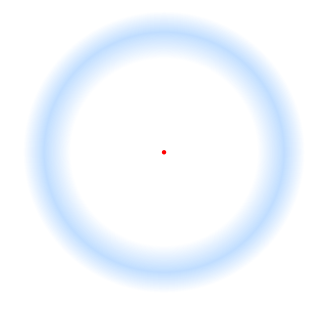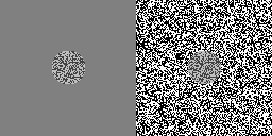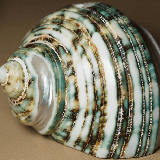Blindsight is the ability of people who are cortically blind due to lesions in their striate cortex, also known as primary visual cortex or V1, to respond to visual stimuli that they do not consciously see. The majority of studies on blindsight are conducted on patients who have the conscious blindness on only one side of their visual field. Following the destruction of the striate cortex, patients are asked to detect, localize, and discriminate amongst visual stimuli that are presented to their blind side, often in a forced-response or guessing situation, even though they do not consciously recognize the visual stimulus. Research shows that blind patients achieve a higher accuracy than would be expected from chance alone. Type 1 blindsight is the term given to this ability to guess—at levels significantly above chance—aspects of a visual stimulus without any conscious awareness of any stimuli. Type 2 blindsight occurs when patients claim to have a feeling that there has been a change within their blind area—e.g. movement—but that it was not a visual percept. Blindsight challenges the common belief that perceptions must enter consciousness to affect our behavior; showing that our behavior can be guided by sensory information of which we have no conscious awareness. It may be thought of as a converse of the form of anosognosia known as Anton–Babinski syndrome, in which there is full cortical blindness along with the confabulation of visual experience.
Iconic memory is the visual sensory memory (SM) register pertaining to the visual domain and a fast-decaying store of visual information. It is a component of the visual memory system which also includes visual short-term memory (VSTM) and long-term memory (LTM). Iconic memory is described as a very brief, pre-categorical, high capacity memory store. It contributes to VSTM by providing a coherent representation of our entire visual perception for a very brief period of time. Iconic memory assists in accounting for phenomena such as change blindness and continuity of experience during saccades. Iconic memory is no longer thought of as a single entity but instead, is composed of at least two distinctive components. Classic experiments including Sperling's partial report paradigm as well as modern techniques continue to provide insight into the nature of this SM store.

Binocular rivalry is a phenomenon of visual perception in which perception alternates between different images presented to each eye.
The McCollough effect is a phenomenon of human visual perception in which colorless gratings appear colored contingent on the orientation of the gratings. It is an aftereffect requiring a period of induction to produce it. For example, if someone alternately looks at a red horizontal grating and a green vertical grating for a few minutes, a black-and-white horizontal grating will then look greenish and a black-and-white vertical grating will then look pinkish. The effect is remarkable because, under certain circumstances, it can last up to three months or more.
Also known as perceptual blindness, inattentive blindness results from a lack of attention that is not associated with vision defects or deficits, as an individual fails to perceive an unexpected stimulus in plain sight. When it becomes impossible to attend to all the stimuli in a given situation, a temporary “blindness” effect can occur, as individuals fail to see unexpected but often salient objects or stimuli. The term was coined by Arien Mack and Irvin Rock in 1992 and was used as the title of their book of the same name, published by MIT press in 1998, in which they describe the discovery of the phenomenon and include a collection of procedures used in describing it. A famous study that demonstrated inattentional blindness asked participants whether or not they noticed a gorilla walking through the scene of a visual task they had been given.

Troxler's fading, or Troxler fading, or the Troxler effect, is an optical illusion affecting visual perception. When one fixates on a particular point for even a short period of time, an unchanging stimulus away from the fixation point will fade away and disappear. Recent research suggests that at least some portion of the perceptual phenomena associated with Troxler's fading occurs in the brain.

The lilac chaser is a visual illusion, also known as the Pac-Man illusion. It consists of 12 lilac, blurred discs arranged in a circle, around a small black, central cross on a grey background. One of the discs disappears briefly, then the next, and the next, and so on, in a clockwise direction. When one stares at the cross for about 5 seconds or so, one sees three different things:
- A gap running around the circle of lilac discs;
- A green disc running around the circle of lilac discs in place of the gap;
- The green disc running around on the grey background, with the lilac discs having disappeared in sequence.

In vision, filling-in phenomena are those responsible for the completion of missing information across the physiological blind spot, and across natural and artificial scotomata. There is also evidence for similar mechanisms of completion in normal visual analysis. Classical demonstrations of perceptual filling-in involve filling in at the blind spot in monocular vision, and images stabilized on the retina either by means of special lenses, or under certain conditions of steady fixation. For example, naturally in monocular vision at the physiological blind spot, the percept is not a hole in the visual field, but the content is “filled-in” based on information from the surrounding visual field. When a textured stimulus is presented centered on but extending beyond the region of the blind spot, a continuous texture is perceived. This partially inferred percept is paradoxically considered more reliable than a percept based on external input..

The Chubb illusion is an optical illusion or error in visual perception in which the apparent contrast of an object varies substantially to most viewers depending on its relative contrast to the field on which it is displayed. These visual illusions are of particular interest to researchers because they may provide valuable insights in regard to the workings of human visual systems.

Motion Induced Blindness (MIB) is a phenomenon of visual disappearance or perceptual illusions observed in the lab, in which stationary visual stimuli disappear as if erased in front of an observer's eyes when masked with a moving background. Most recent research has shown that microsaccades counteract disappearance but are neither necessary nor sufficient to account for MIB.

The neural basis of prey detection, recognition, and orientation was studied in depth by Jörg-Peter Ewert in a series of experiments that made the toad visual system a model system in neuroethology. He began by observing the natural prey catching behavior of the common European toad.

The neural correlates of consciousness (NCC) constitute the minimal set of neuronal events and mechanisms sufficient for a specific conscious percept. Neuroscientists use empirical approaches to discover neural correlates of subjective phenomena; that is, neural changes which necessarily and regularly correlate with a specific experience. The set should be minimal because, under the assumption that the brain is sufficient to give rise to any given conscious experience, the question is which of its components is necessary to produce it.

The visual N1 is a visual evoked potential, a type of event-related electrical potential (ERP), that is produced in the brain and recorded on the scalp. The N1 is so named to reflect the polarity and typical timing of the component. The "N" indicates that the polarity of the component is negative with respect to an average mastoid reference. The "1" originally indicated that it was the first negative-going component, but it now better indexes the typical peak of this component, which is around 150 to 200 milliseconds post-stimulus. The N1 deflection may be detected at most recording sites, including the occipital, parietal, central, and frontal electrode sites. Although, the visual N1 is widely distributed over the entire scalp, it peaks earlier over frontal than posterior regions of the scalp, suggestive of distinct neural and/or cognitive correlates. The N1 is elicited by visual stimuli, and is part of the visual evoked potential – a series of voltage deflections observed in response to visual onsets, offsets, and changes. Both the right and left hemispheres generate an N1, but the laterality of the N1 depends on whether a stimulus is presented centrally, laterally, or bilaterally. When a stimulus is presented centrally, the N1 is bilateral. When presented laterally, the N1 is larger, earlier, and contralateral to the visual field of the stimulus. When two visual stimuli are presented, one in each visual field, the N1 is bilateral. In the latter case, the N1's asymmetrical skewedness is modulated by attention. Additionally, its amplitude is influenced by selective attention, and thus it has been used to study a variety of attentional processes.
Chronostasis is a type of temporal illusion in which the first impression following the introduction of a new event or task-demand to the brain can appear to be extended in time. For example, chronostasis temporarily occurs when fixating on a target stimulus, immediately following a saccade. This elicits an overestimation in the temporal duration for which that target stimulus was perceived. This effect can extend apparent durations by up to 500 ms and is consistent with the idea that the visual system models events prior to perception.
Transsaccadic memory is the neural process that allows humans to perceive their surroundings as a seamless, unified image despite rapid changes in fixation points. The human eyes move rapidly and repeatedly, focusing on a single point for only a short period of time before moving to the next point. These rapid eye movements are called saccades. If a video camera were to perform such high speed changes in focal points, the image on screen would be a blurry, nauseating mess. Despite this rapidly changing input to the visual system, the normal experience is of a stable visual world; an example of perceptual constancy. Transsaccadic memory is a system that contributes to this stability.
Continuous flash suppression (CFS) is an adapted version of the original flash suppression method, first reported in 2004. In CFS, the first eye is presented with a static stimulus, such as a schematic face, while the second eye is presented with a series of rapidly changing stimuli. The result is the static stimulus becomes consciously repressed by the stimuli presented in the second eye. A variant of CFS to suppress a dynamic stimulus is also reported
Visual masking occurs when the perception of one stimulus, called a target, is affected by the presence of another stimulus, called a mask. With respect to time, there are three different types of masking – forward, backward, and simultaneous. These correspond to trials where the mask precedes the target, follows the disappearance of the target, or appears at the same time as the target, respectively. In the spatial domain, there are two different types of masking: pattern masking and metacontrast. Pattern masking occurs when the target and mask are presented within the same retinal location, and metacontrast occurs when the mask does not overlap with the target location.
Surround suppression is where the relative firing rate of a neuron may under certain conditions decrease when a particular stimulus is enlarged. It is has been observed in electrophysiology studies of the brain and has been noted in many sensory neurons, most notably in the early visual system. Surround suppression is defined as a reduction in the activity of a neuron in response to a stimulus outside its classical receptive field. note, quoting Kuffler (1953), "not only the areas from which responses can actually be set up by retinal illumination may be included in a definition of the receptive field but also all areas which show a functional connection, by an inhibitory or excitatory effect on a ganglion cell." The necessary functional connections with other neurons influenced by stimulation outside a particular area and by dynamic processes in general, and the absence of a theoretical description of a system state to be treated as a baseline, deprive the term "classical receptive field" of functional meaning. The descriptor "surround suppression" suffers from a similar problem, as the activities of neurons in the "surround" of the "classical receptive field are similarly determined by connectivities and processes involving neurons beyond it.) This nonlinear effect is one of many that reveals the complexity of biological sensory systems, and the connections of properties of neurons that may cause this effect are still being studied. The characteristics, mechanisms, and perceptual consequences of this phenomenon are of interest to many communities, including neurobiology, computational neuroscience, psychology, and computer vision.
Binocular switch suppression (BSS) is a fairly new technique developed to suppress usually salient images from one's awareness. Unlike previous methods such as visual masking, this new empirical method allows one to investigate the neural and behavioural consequences during the period of visual suppression itself and not just after the presentation of the target stimuli. Suppressing usually salient images from an individual's awareness is regarded as a popular experimental manipulation in visual perception and cognitive neuroscience. Some popular and familiar examples of such manipulation include binocular rivalry, continuous flash suppression (CFS), visual masking and flicker switch suppression.








